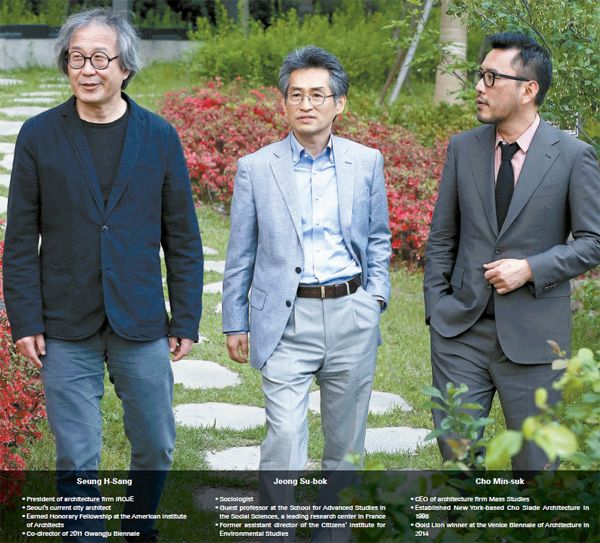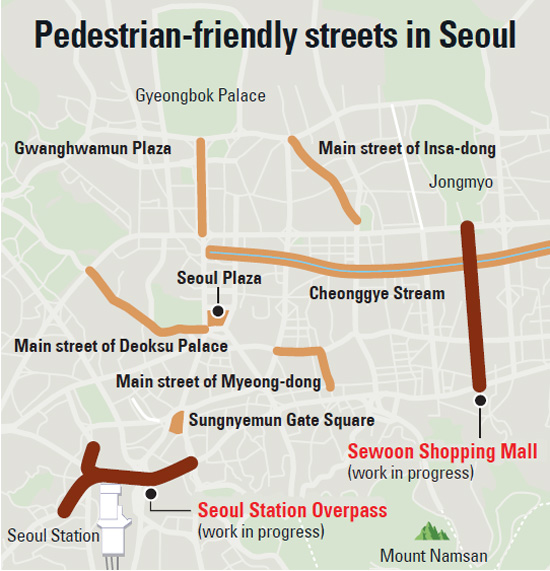Experts debate Seoul’s elevated park

In 1998, boulevards solely dedicated to walkers were created in Myeong-dong and Insa-dong in bustling central Seoul, and traffic was banned. This move was followed by the establishment of Seoul Plaza, Gwanghwamun Square and Sungnyemun Gate Square.
Years later, in 2003, a highway overpass was removed from the Cheonggye Stream. Lee Myung-bak, the mayor of Seoul at the time, ordered for the unsightly waterway to be redeveloped.
The refurbished stream has become a landmark in central Seoul, always brimming with cultural events and people enjoying the scenic view day and night.
However, the Seoul Metropolitan Government’s latest attempt to turn the Seoul Station Overpass into an elevated park, inspired by New York’s High Line, a public space built on a disused railway, has received a strong backlash.

In the face of these allegations, the Seoul government is promoting “walkable urbanism” as its intention behind the project. The phrase roughly means making the city more pedestrian-friendly, a concept that has become a global standard in many metropolitan areas around the world.
Due to the ongoing dispute, the JoongAng Ilbo, an affiliate of the Korea JoongAng Daily, has invited three high-profile figures in relevant fields to debate the controversy: Seung H-Sang, Seoul city’s official architect; Cho Min-suk, the CEO of architecture firm Mass Studies; and Jeong Su-bok, a writer and sociologist.

Q. What do you think about the concept of walkable urbanism?
A. Seung: Historically, a city goes through two sets of transformations. One is a radical expansion of the city because of industrialization and democratization. With the invention of automobiles, the speed of expansion gets faster. When a city stops expanding in the 21st century, people start to emphasize health and environment, leading them to prefer a city that is a nice place to walk rather than one that has many cars.
Jeong: Many cities in Italy and Spain completely ban cars from entering the centers and only allow trams. It means that the inner city itself becomes exclusively for pedestrians. In England and Germany, there are continuous attempts to scale back on roads, for example. They achieve this by downsizing a four-lane road to a two-lane road.
Cho: For the past 100 years, Seoul’s population has increased by 50 times. For the first 50 years, it increased by five times, while in the latter half [during the industrialization period] it increased by 10. Now the city has entered a stagnant period. If we compare Seoul’s growth rate to the growth rate of big international cities, it is in the phase of adolescence. Until now, the city needed growth hormones and the number of roads provided those hormones. But now the physical growth has ended and the city has to achieve mental maturity. Seoul needs to change now.
It seems like there is an agreement that Seoul, which has focused on expanding its size, has to now accomplish qualitative development, which means realizing walkable urbanism. But why is qualitative development, or being mature, considered equivalent to making a city walkable?
Seung: In the past, the goal was to shorten the time it takes to travel somewhere by car. Now, it is considered much more precious to thoroughly experience a certain area. This is apparent when you think about which neighborhoods are becoming trendy these days.
What is the global trend in terms of developing a metropolitan area?
Cho: In 2010, New York announced what are called the “Active Design Guidelines” [which promoted physical activity and health when designing a city]. It means that health issues have become the priority for people living in cities.
In ancient times, people died because of infectious diseases. Now, a lot of people suffer from chronic illnesses. The gist of the “Active Design Guidelines” are to design and construct a city from the beginning stage to make it more walkable. New York, which has always been an exemplary city expansion model, is now setting a new trend. I lived in New York and Amsterdam for years, and because of that I don’t own a car.
What is the current state of Seoul? Also, what are some points to consider before completely transforming the Seoul Station Overpass into a high-rise park?
Seung: If we go to foreign cities, it is possible to walk endlessly. But what about here in Seoul? People say that many roads for pedestrians were paved in the past 20 years, but most of them are now demolished and have been shattered to debris. The city’s plan is to pave pedestrian roads that stretch out endlessly. We are currently working on drawing a “public map” where people can easily comprehend how public areas such as parks and plazas, as well as roads, are arranged in the city.
Jeong: People shouldn’t oppose the plan just because the city government or the president is pursuing it. The key should be to figure out whether the leader is taking into consideration the trends and the citizens’ demands. The biggest difference between a civil servant and an expert engaged in the project is that the civil servant has the ability to “communicate.” In every decision-making process, the citizens’ opinion should be reflected.
Also, The government employee should always think about what is needed. They should not also think about what can be finished within their four-year tenure. City development is something that should be completed over a long period of time. One should always respect the achievements of the former leader and think about how they can continue in the later generations.
Let me suggest something. How about having the designer or the architect give their name to a certain soon-to-be erected landmark? For example, the overpass should be under the name of Seung Hyo-sang instead of Seoul Mayor Park Won-soon. This was how it was done for Paris’ Promenade Plantee. Landscape architect Jacques Vergely and architect Philippe Mathieux’s names were prominent during the development of this project. It seems small, but it would make a big difference.
Cho: As a citizen, let me suggest another thing to Seung. Allowing a pedestrian to use the overpass could be an excellent solution to connect the two separate areas.
However, please don’t let the surrounding area turn into a place where you find one Starbucks after another. It is a common phenomena that when young vendors make a neighborhood trendy, the soaring rent prices kick them out in reverse. But in order to maintain a certain area’s identity, those young vendors are necessary. Please don’t let that kind of character vanish.
Seung: I couldn’t agree with you more. Remodeling should not be proceeded with at once when it starts. If there is good feedback about one change, I would proceed with it, but if there are negative comments, I would revise the design plan and ask for advice again. I’ll do it slowly, step by step.
* Seung H-Sang
President of architecture firm IROJE
Seoul’s current city architect
Earned Honorary Fellowship at the American Institute of Architects
Co-director of 2011 Gwangju Biennale
* Jeong Su-bok
Sociologist
Guest professor at the School for Advanced Studies in the Social Sciences, a leading research center in France
Former assistant director of the Citizens’ Institute for Environmental Studies
* Cho Min-suk
CEO of architecture firm Mass Studies
Established New York-based Cho Slade Architecture in 1998
Gold Lion winner at the Venice Biennale of Architecture in 2014
BY KANG IN-SIK, KANG KI-HEON AND JANG HYUK-JIN [jin.eunsoo@joongang.co.kr]










with the Korea JoongAng Daily
To write comments, please log in to one of the accounts.
Standards Board Policy (0/250자)